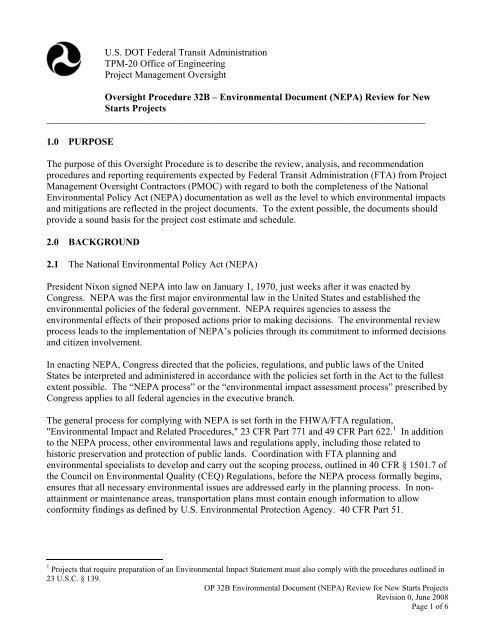FTA Oversight Procedures - Federal Transit Administration - U.S. ...
FTA Oversight Procedures - Federal Transit Administration - U.S. ...
FTA Oversight Procedures - Federal Transit Administration - U.S. ...
You also want an ePaper? Increase the reach of your titles
YUMPU automatically turns print PDFs into web optimized ePapers that Google loves.
U.S. DOT <strong>Federal</strong> <strong>Transit</strong> <strong>Administration</strong><br />
TPM-20 Office of Engineering<br />
Project Management <strong>Oversight</strong><br />
<strong>Oversight</strong> Procedure 32B – Environmental Document (NEPA) Review for New<br />
Starts Projects<br />
______________________________________________________________________________<br />
1.0 PURPOSE<br />
The purpose of this <strong>Oversight</strong> Procedure is to describe the review, analysis, and recommendation<br />
procedures and reporting requirements expected by <strong>Federal</strong> <strong>Transit</strong> <strong>Administration</strong> (<strong>FTA</strong>) from Project<br />
Management <strong>Oversight</strong> Contractors (PMOC) with regard to both the completeness of the National<br />
Environmental Policy Act (NEPA) documentation as well as the level to which environmental impacts<br />
and mitigations are reflected in the project documents. To the extent possible, the documents should<br />
provide a sound basis for the project cost estimate and schedule.<br />
2.0 BACKGROUND<br />
2.1 The National Environmental Policy Act (NEPA)<br />
President Nixon signed NEPA into law on January 1, 1970, just weeks after it was enacted by<br />
Congress. NEPA was the first major environmental law in the United States and established the<br />
environmental policies of the federal government. NEPA requires agencies to assess the<br />
environmental effects of their proposed actions prior to making decisions. The environmental review<br />
process leads to the implementation of NEPA’s policies through its commitment to informed decisions<br />
and citizen involvement.<br />
In enacting NEPA, Congress directed that the policies, regulations, and public laws of the United<br />
States be interpreted and administered in accordance with the policies set forth in the Act to the fullest<br />
extent possible. The “NEPA process” or the “environmental impact assessment process” prescribed by<br />
Congress applies to all federal agencies in the executive branch.<br />
The general process for complying with NEPA is set forth in the FHWA/<strong>FTA</strong> regulation,<br />
"Environmental Impact and Related <strong>Procedures</strong>," 23 CFR Part 771 and 49 CFR Part 622. 1 In addition<br />
to the NEPA process, other environmental laws and regulations apply, including those related to<br />
historic preservation and protection of public lands. Coordination with <strong>FTA</strong> planning and<br />
environmental specialists to develop and carry out the scoping process, outlined in 40 CFR § 1501.7 of<br />
the Council on Environmental Quality (CEQ) Regulations, before the NEPA process formally begins,<br />
ensures that all necessary environmental issues are addressed early in the planning process. In nonattainment<br />
or maintenance areas, transportation plans must contain enough information to allow<br />
conformity findings as defined by U.S. Environmental Protection Agency. 40 CFR Part 51.<br />
1<br />
Projects that require preparation of an Environmental Impact Statement must also comply with the procedures outlined in<br />
23 U.S.C. § 139.<br />
OP 32B Environmental Document (NEPA) Review for New Starts Projects<br />
Revision 0, June 2008<br />
Page 1 of 6

















